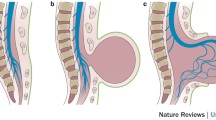Abstract
From 1976 to 1994, we followed 55 children with occult spinal dysraphism (OSD). The average age at diagnosis was 4.5 years (range: 24 days–21 years). In 13 cases the OSD was associated with anorectal anomalies. Urologic symptoms were present at diagnosis in 24 children (43%), but urinary incontinence affected all patients in the evolution of the OSD. At diagnosis, all children underwent complete neurourologic and urodynamic evaluation. Nine required early neurosurgical correction, before 3 years of age. During follow-up, intermittent clean catheterization was started in all patients. Vesicoureteral reflux was present or developed in 17 patients: 15 underwent endoscopic procedures and 2 required bladder augmentation because of upper-tract and renal-function deterioration. Endoscopic treatment for urinary incontinence was performed in 3 children. At long-term follow-up (6 to 18 years), socially acceptable continence was achieved in 78% of the children; renal failure occurred in 8. The long-term results were analyzed in order to compare the evolution of urinary continence and renal function in children with OSD with or without neurosurgery.
Similar content being viewed by others
References
Assaad A, Mousy A, Kotb M, Hafez M (1989) Spinal dysraphism: experience with 250 cases operated. Childs Nerv Syst 5: 324–329
Bauer SB, Hallet M, Khashbin S, Lebowitz RL, Winston KR, Gibson S, Colodny AH, Retik AB (1984) Predictive value of urodynamic evaluation in newborns with myelodysplasia. JAMA 252: 650–653
Boone D, Parsons D, Leachmann SM, Sherwood T (1985) Spina bifida occulta, lesion or anomaly? Clin Radiol 36: 159–165
Capozza N, De Gennaro M, Lais A (1987) Clean intermittent catheterization in management of children with myelodysplasia. Acta Med Rom 25: 336
Craigmaile TK (1977) Congenital anomalies of the spine. In: Ruge D, Wiltse L (eds) Spinal disorders: diagnosis and treatment. Lea and Febiger, Philadelphia, pp 223–245
De Gennaro M, Lais A, Caldarelli M (1990) Variability della situazione urodinamica nei bambini con mielomeningocele e suo eventuale rapporto con la tethered cord. Aula Med 3: 29
De Gennaro M, Lais A, Fariello G (1991) Early diagnosis and treatment of spinal dysraphism to prevent urinary incontinence. Eur Urol 929
Fidas A, MacDonalds HL, Elken RA, Wild SR, Chilsom GD, Scott R (1987) Prevalence and patterns of spina bifida occulta in 2707 normal adults. Clin Radiol 38: 537–540
Geraniotis E, Koff SA, Enrile B (1988) The prophylactic use of clean intermittent catheterization in the treatment of infants and young children with myelomeningocele and neurogenic bladder dysfunction. J Urol 139: 85
Gross AJ, Michael T, Godmann F, Weigel K, Hulamd H (1993) Urological findings in patients with neurosurgically treated tethered spinal cord. J Urol 149: 1510–1511
Khoury AE, Hendrick EB, McLoire GA, Kulkarin A, Churchill BM (1990) Occult spinal dysraphism: clinical and urodynamic outcome after division of the filum terminale. J Urol 144: 426–429
McGuire EJ, Woodside JR, Borden TA, Weiss RM (1981) Prognostic value of urodynamic testing in myelodysplastic patients. J Urol 126: 205–210
O'Neil P, Singh J (1991) Occult spinal dysraphism in children: need for early neurosurgical referral. Childs Nerv Syst 7: 309–311
Yamada S, Knierim D, Yankura M, Schultz R, Maeda G (1983) Tethered cord syndrome. J Am Paraplegia Soc 6: 58–60
Author information
Authors and Affiliations
Rights and permissions
About this article
Cite this article
Silveri, M., Capitanucci, M.L., Capozza, N. et al. Occult spinal dysraphism: neurogenic voiding dysfunction and long-term urologic follow-up. Pediatr Surg Int 12, 148–150 (1997). https://doi.org/10.1007/BF01349985
Accepted:
Issue Date:
DOI: https://doi.org/10.1007/BF01349985



